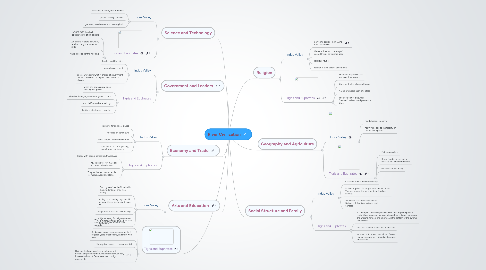
1. Tigris and Euphrates
1.1. Writing was called cuneiform, they used it to keep business accounts and records.
1.2. Scribes were paid to create documents. It required years of schooling, and most were men.
1.3. Math system based on the number 60.
1.4. Cylinder Seals are small stone cylinders with designs engraved on them. When rolled in wet clay, it leaves an imprint. Seals were used to sign documents.
2. Government and Leaders
2.1. Indus Valley
2.1.1. Rajahs ruled the cities
2.1.2. central government
2.1.3. priests were somewhat in charge of government because they held the highest level in social classes
2.2. Tigris and Euphrates
2.2.1. when city states grew, priest held highest power
2.2.2. when battle began, war cheifs gained control
2.2.3. war cheifs soon became kings
2.2.4. the kings later formed dynastys
3. Economy and Trade
3.1. Indus Valley
3.1.1. traded to far and near places
3.1.2. focused on agriculture
3.1.3. most people farmed and herded
3.1.4. specialized in crafts; pottery, metal work, and jewelry
3.2. Tigris and Euphrates
3.2.1. Traded with people across Southwest Asia
3.2.2. They traded for raw materials such as wood and metals.
3.2.3. They exchanged woven textiles for metals, wood and stone.
4. Arts and Education
4.1. Indus Valley
4.1.1. Guru (type of teacher) lived with their student until they were twenty
4.1.2. not big on schooling, boys would be taught from five to eight years old
4.1.3. discipline was essense of schooling
4.1.4. subjects were of a religious nature and schooling taught about government
5. Science and Technology
5.1. Indus Valley
5.1.1. wells dug in courtyards of homes
5.1.2. public drainage systems
5.1.3. granaries, warehouses, and meeting halls
5.2. Tigris and Euphrates
5.2.1. In 3000 BCE they built structures out of mud bricks
5.2.2. Dug basins to store rainwater, canals to carry the water to fields
5.2.3. Made dikes to control flooding
6. Religion
6.1. Indus Valley
6.1.1. prayed to spirits - Indrua who ruled over heaven
6.1.2. fire sacrifices and chanting of sacred hymns to worship gods
6.1.3. religious rituals.
6.1.4. religion is a big part of government
6.2. Tigris and Euphrates
6.2.1. Practiced Polytheism, the worship of many gods.
6.2.2. Gods controlled all natural forces
6.2.3. A God protected each city-state
6.2.4. The people built ziggurats (temples) to honor and please the Gods
7. Geography and Agriculture
7.1. Indus Valley
7.1.1. flood deposits into river
7.1.2. heavy rains add to the fertility of the northern plains
7.2. Tigris and Euphrates
7.2.1. Flat, swampy land
7.2.2. Rivers flooded in the spring creating silt, a rich fertile mud.
7.2.3. Grew wheat and Barley
8. Social Structure and Family
8.1. Indus Valley
8.1.1. Caste determine who could marry
8.1.2. Brahmins: priest, Kshatriyas: warriors and rulers, Vaisyas: traders, farmers, herders, Sundras: servents
8.1.3. Varnas are classes which include: Brahmins, Kshatriyas, Vaisyas, and Sundras
8.2. Tigris and Euphrates
8.2.1. At the top of the social pyramid were the Kings and priests. Under them were landowners and merchants. Below them were the artisans, farmers and laborers. At the bottom of the pyramid were slaves.
8.2.2. Men had political power, and made laws.
8.2.3. Women took care of the children. Some higher-class women with education were priestesses.
